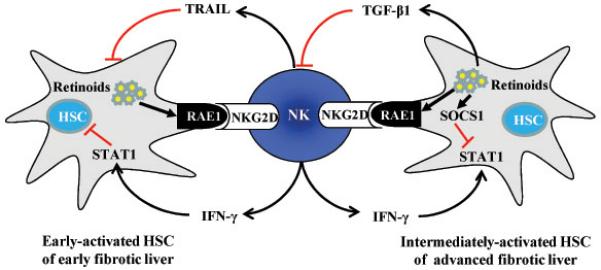Fig. 8.

A double edged sword role of retinol metabolites in HSCs against NK cell activation. During HSC activation, retinols are metabolized into Rald or RA, which affect the interaction of NK and HSCs in 2 ways. (1) RA induces expression of NK cell activating ligand RAE1, which then activates NK cells through interaction with NKG2D. Activated NK cells can directly kill early-activated HSCs via releasing TRAIL or inhibit HSCs via releasing IFN-γ. IFN-γ induces cell cycle arrest and apoptosis of HSCs via activation of STAT1. (2) Retinoids (Rald and RA) can inhibit IFN-γ-mediated activation of STAT1 via induction of SOCS1, a key negative inhibitor of IFN-γ signaling, in intermediately-activated HSCs. Also, RA can activate latent TGF-β, which then inhibits NK cell activity. Therefore, retinol metabolism during HSC activation can promote NK cell activation via induction of RAE1, but can also downregulate NK cell activity via induction of TGF-β that inhibits NK cell activity, or induction of SOCS1 that inhibits IFN-γ signaling.
